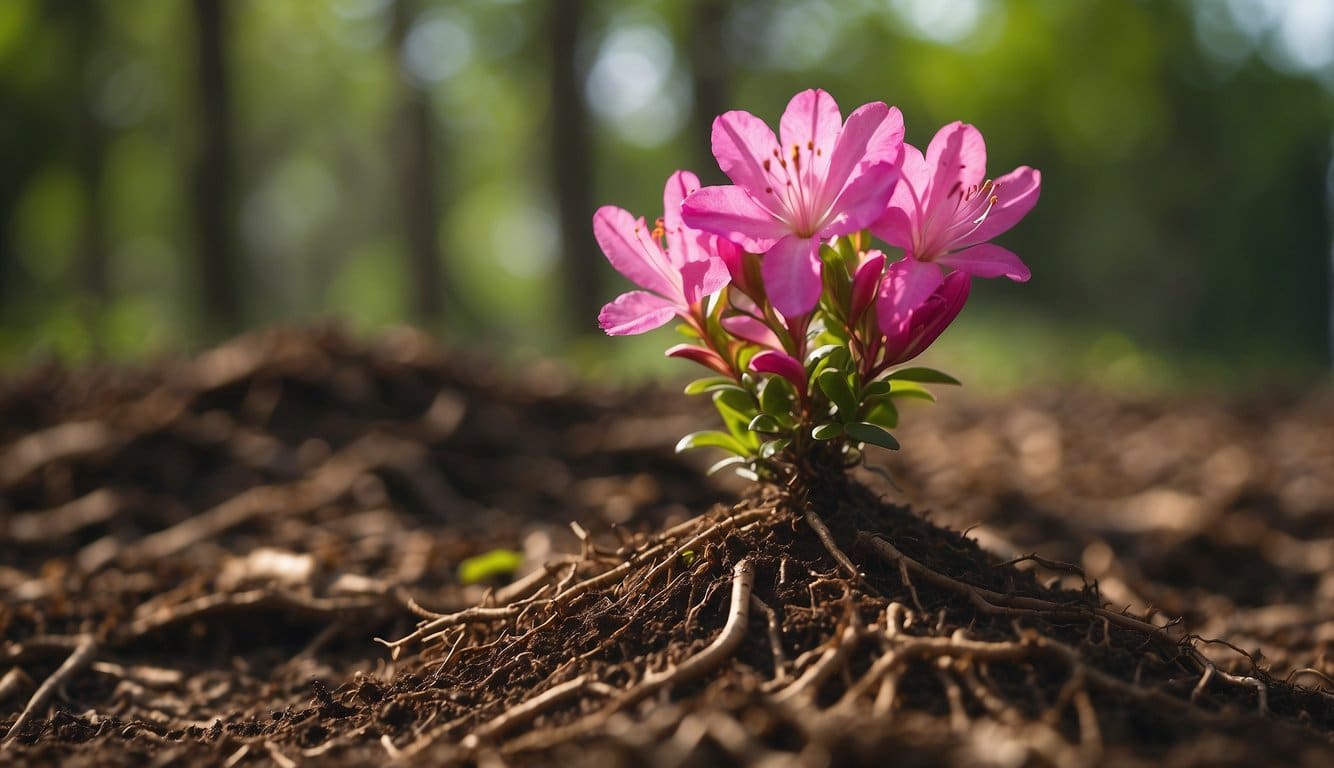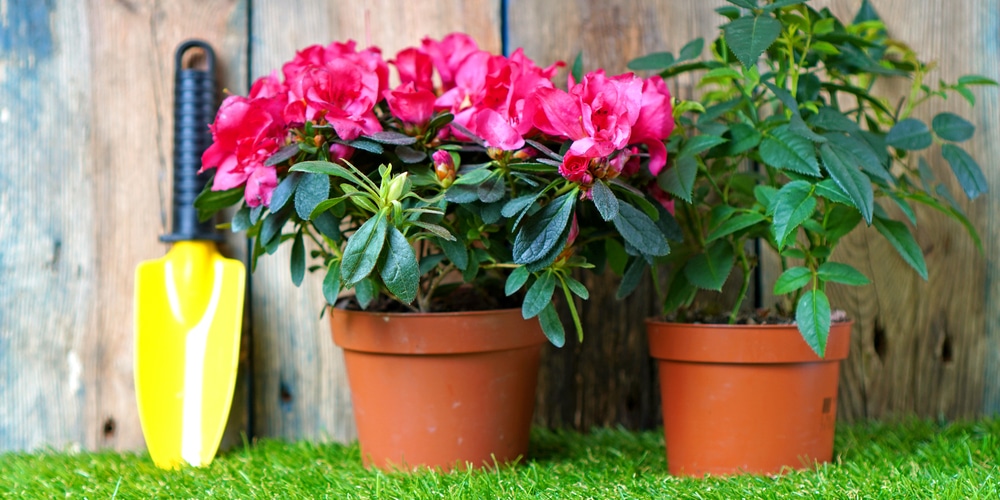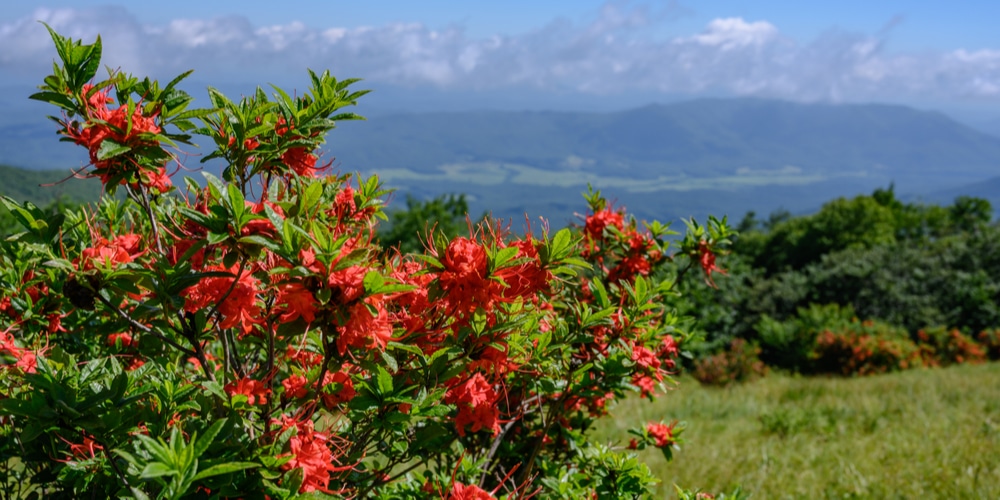Gardening enthusiasts often select plants for their aesthetic appeal, ease of care, or suitability for their garden’s specific conditions.
Azaleas, flowering plants known for their vibrant blooms and broad appeal, are frequently chosen to enhance landscapes.
An important consideration when planting azaleas—or any plants, for that matter—is the nature of their root system and whether it could become problematic over time.
Azalea roots are generally shallow and non-invasive, making them suitable for a variety of garden situations without causing concern for the displacement of nearby plants or structures.
Typically, azalea roots extend horizontally rather than deep into the ground, creating a network of roots that stays predominantly within a few feet of the trunk.
While they can spread to form a thick mat, these roots do not aggressively seek out and damage foundations or infrastructure, like some invasive plant species do.
Key Takeaways
- Azaleas are favored for their vibrant flowers and adaptability in various garden settings.
- Their root systems are shallow, spreading horizontally rather than deeply.
- Azalea roots are non-invasive, reducing concerns about damage to structures and nearby plant life.
Quality Azaleas
Azalea Root Characteristics
The roots of azaleas are known for their non-invasive nature, preferring a well-defined space close to their trunk and not growing too deep into the soil.
Growth Patterns
Azalea roots typically spread laterally near the soil surface. They do not extend far beyond the trunk, generally reaching out to about three to six feet.
This growth pattern means azaleas are suitable for planting near structures without the risk of foundational damage.
Root System Depth
The depth of an azalea root system is relatively shallow, usually not exceeding 12 inches beneath the soil surface.
This characteristic permits easy cultivation and maintenance without the need for deep digging that could damage the roots.
In well-drained conditions, the roots form a compact mass of fine feeder roots within this depth range.
Impact on the Environment
Azalea roots typically exhibit non-invasive behavior, emphasizing their compatibility with surrounding ecosystems. However, their interaction with soil structure and native flora merits an examination of their environmental impact.
Effects on Soil Structure
Azalea roots tend to be shallow and spread horizontally rather than deeply penetrating the soil.
As a result, they rarely disrupt underground utilities or foundations, characteristic of more invasive species.
The shallow root system of azaleas can benefit soil structure by minimizing soil erosion, especially on slopes, where the interlocking roots can hold soil particles together and absorb water runoff.
Interaction with Native Flora
Azaleas generally coexist well with native plants, given that they do not aggressively compete for resources.
Their modest root expansion limits interference with the root systems of nearby vegetation.
In conditions favorable for azaleas, such as acidic and well-drained soil, they can thrive without substantially encroaching on the growth of local flora.
This balance ensures that azaleas can be a colorful addition to gardens and landscapes without significantly disrupting existing ecosystems.
Managing Azalea Root Growth
Azalea roots are generally non-invasive, but proper management ensures they remain healthy and do not interfere with surrounding flora.
Cultivation Practices
When cultivating azaleas, gardeners should be mindful of providing adequate space for root development.
They should plant azaleas in an area where the roots have room to spread without encountering obstacles.
Soil quality is crucial; azaleas prefer acidic soils with high organic content that ensures good drainage.
Here are the key practices:
- Spacing: Ensure azaleas are spaced to allow for their natural root expansion, generally within 3-6 feet of the trunk.
- Soil Preparation: Amend the soil with organic matter to promote good drainage and nutrient availability.
- Watering: Maintain consistent moisture while avoiding waterlogging, which could lead to root rot. Mulching helps conserve moisture and keep roots cool.
- pH Management: Regularly check soil pH levels to maintain the acidity azaleas crave, usually between pH 4.5 and 6.0.
Root Pruning Techniques
Occasionally, a gardener may need to prune azalea roots to rejuvenate an older plant or control its size.
Effective root pruning involves:
- Timeliness: Pruning should take place during dormancy, typically in late fall or early winter.
- Technique: Using clean, sharp tools, make cuts vertically into the soil around the plant to sever extended roots.
- Aftercare: Post-pruning, provide the azalea with gentle watering and avoid fertilization until new growth appears.
Frequently Asked Questions
Gardeners often have questions about the root systems of azaleas and their impact on surrounding structures. This section seeks to address common inquiries.
How far can I expect azalea roots to extend from the base of the plant?
Azalea roots are known for being relatively shallow, usually extending around 12 inches deep and not far from the plant’s base. Variations can occur depending on the azalea species.
Is it safe to position azaleas near residential structures?
Given that azalea roots are not typically invasive or deeply penetrating, planting azaleas reasonably close to residential structures is generally safe.
Could azalea plant roots potentially compromise the integrity of building foundations?
Azalea roots are unlikely to compromise the integrity of building foundations due to their non-invasive nature and shallow growth pattern.
What is the difficulty level involved in excavating azalea roots?
Excavating azalea roots is typically not a difficult task because the root system is shallow and less extensive than those of larger shrubs and trees.
Are there specific spacing recommendations when landscaping with azaleas?
Landscapers generally recommend planting azaleas at least 2-3 feet apart to accommodate their root spread and ensure proper growth.
What preventative measures can be taken to protect structures from potential azalea root growth?
While azaleas are not known for invasive root systems, it’s prudent to keep them several feet away from foundations, sidewalks, and plumbing to avoid any potential issues.
Last update on 2025-06-06 / Affiliate links / Images from Amazon Product Advertising API






